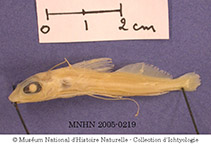| Family: |
Pimelodidae (Long-whiskered catfishes) |
| Max. size: |
14.09 cm SL (male/unsexed) |
| Environment: |
benthopelagic; freshwater |
| Distribution: |
South America: upper Maroni River basin in French Guiana and Suriname. |
| Diagnosis: |
Dorsal spines (total): 2-2; Dorsal soft rays (total): 6-6; Anal soft rays: 8-8; Vertebrae: 46-47. Distinguished with the following three apomorphic anatomical complexes: 1.) mouth ventral and transverse, supported by reoriented, much expanded premaxillae and foreshortened mandibles; premaxillae and dentaries densely covered with robust, needle-like teeth arranged in a steeply-descending, antero-posterior size series. 2.) lateral margins of orbit and otic region elevated with textured ridges developed from the frontal, sphenotic and pterotic bones surrounding the supraorbital, otic and postotic lateralis sensory canals. 3.) Interorbital septum severely compressed as thin, apparently median, bony sheet. Among Pimelodidae, it shares apomorphic features, placing it near the diverse Calophysus-Pimelodus clade (Ref. 83450). |
| Biology: |
Collected from large rivers with swift currents and bedrock to boulder-strewn substrates (Ref. 83450). |
| IUCN Red List Status: |
Vulnerable (VU); Date assessed: 14 January 2021 (B1ab(iii)) Ref. (130435)
|
| Threat to humans: |
harmless |
| Country info: |
|
Source and more info: www.fishbase.org. For personal, classroom, and other internal use only. Not for publication.

